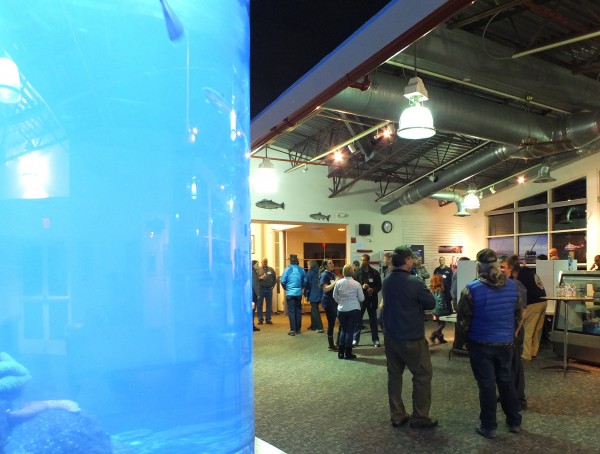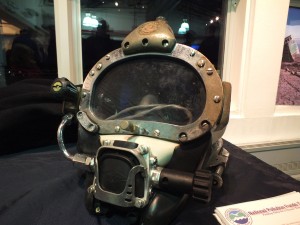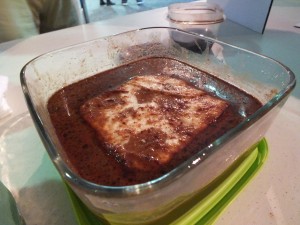Imagine a small, but very busy high school science fair, and you’ll have a pretty good idea of what it was like at the Coast Guard’s open house on Tuesday to explain the imminent salvage of the wrecked tug Challenger. The neglected 96-foot World War II era vessel sank last September in Gastineau Channel just across from the Juneau Yacht Club.

During the event at the Douglas Island Pink and Chum facility, visitors milled through a handful of tables with propped-up poster boards showing enlarged pictures, timelines and detailed plans of action. Separate slideshows of area weather and the vessel’s history repeated on a set of monitors, a diving helmet was put on display, and small metal flashers on a wire demonstrated a bird deterrent. There was even a demonstration of how an absorbent pad would soak up oil.

The Coast Guard is worried there could be as much as 9,500 gallons of diesel and lube oil still on board which would threaten the environment. As the rotting vessel is brought up, the wreck could easily cause a full-blown oil spill. Right now, roughly a cup of unrecoverable oil is trickling to surface a day.
As a precaution, Coast Guard Petty Officer Jeffry Crews said they’ll have containment boom placed around the wreck as it’s lifted up.
“At no point should this vessel be in a position where it can discharge a significant amount of oil into the environment where we can’t control it and collect it,” Crews said.
Diversion or exclusion boom will be placed around the intertidal mouths of nearby creeks and near DIPAC.
“They just put salmon fry in the water a couple weeks ago. And they have two or three pens of salmon fry, the net pens behind here,” Crews said. “We want to make sure those species are protected because they’re a commercial species for Alaska. They’re very important to the commercial health of the state. One of the things that we don’t want impacted is Alaska seafood.”

Crews, a marine science technician, brought a glass food container filled with an oily-looking substance. It was actually chocolate powder mixed with corn oil that was being soaked up with a small portion of a polypropolene absorbent pad.
“It can be a volume significantly greater than the volume of the pad,” Crews said. “One pad can pick up a quarter pound of stuff.”
Crews said they want to keep any oil from drifting into the Mendenhall Wetlands State Game Refuge. They’re also concerned about protected species such as sea lions, harbor seals, humpback whales and killer whales, even though not all of those mammals frequent the area this time of year.
Bob Mattson, on-scene coordinator for the Alaska Department of Environmental Conservation, said — just in case — they’ll have additional boom pre-staged at the Yacht Club.
Mattson said Gastineau Channel’s speedy tidal flows will be a big factor in boom placement.
“The currents are what really carry the oil,” Mattson said. “It’s not so much the wind.”
Mattson also said timing is key for effective booming.
“If it goes beyond a tide cycle, then you have to take down the boom you have for one tide cycle and replace it to protect on the other side of the tide cycle,” Mattson said. “And that’s true not just for the Challenger. It’s every spill that we set boom out for. It has to be tended and maintained through tide cycles.”
Skimmers will be available in case of a big spill. But they are usually effective only with thick crude oil in light winds and calm seas, while absorbent materials are better for soaking up refined oil products like diesel fuel and lube oil.
As the Challenger is being lifted up, a pair of federal biologists will circle the salvage site in a skiff and haze any birds to discourage them from landing in the area.

Marc Pratt, district supervisor for the U.S. Department of Agriculture’s Wildlife Service Program, said they want to make sure eagles, ravens, gulls and ducks don’t get oiled.
Pratt said they’ll just maintain a presence and use noisemakers.
“So, if the contaminants are explosive, we don’t want to be using cracker shells or any sort kind of a pyrotechnic that would be making a spark,” Pratt said. “What we’re going to be using is more air horns and stuff like that.”
Kyle Watson, project manager for Global Diving & Salvage, said they’ll likely move the 280-foot derrick barge Brightwater over the Challenger wreck this weekend.
“This one is pretty straightforward,” Watson said.
The water is relatively shallow at 50 feet, the current is only 2 knots, visibility is good, and the bottom sediment is a hard-packed clay.
“All in all, things have been going pretty smooth,” Watson said.
Watson said the tug’s hull appears solid and intact, but the vessel is rotting above the waterline. So, he said they’re going to take their time. The hoist operation could start as soon as Sunday and last 18 to 24 hours depending on the amount of vessel damage.
“Nothing happens really fast when it comes time to raise a large vessel like this. We take things very slow,” Watson said. “The safety of the crew is our first priority. We double-check and triple-check everything before we make any movements with the crane, because we’ll have divers in the water during the operation.”
Divers have already rigged the tug so that it can be easily hoisted up. Watson said they have a device called a spreader beam that is in the shape of a box.
“That is what will hang from the crane,” Watson said. “What that does is keep the straps that are underneath the boat from compressing in the sides of the wreck and collapsing the boat. So, it keeps the weight evenly distributed around the bottom of the vessel.”
Watson said they’ll bring the wrecked tug just to the surface. They don’t need to completely pull it out of the water.
Then, they’ll patch any holes in the hull, dewater the vessel and tow it to the AJ Dock. That’s where crews will remove any hazardous materials like fire extinguishers, asbestos, and the oil and fuel that is believed to be located in tanks under the aft structure.
The tug will be dismantled after it is moved to Thane.
Matt Miller is a reporter at KTOO in Juneau.




